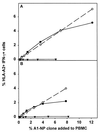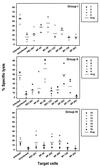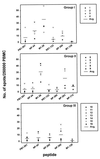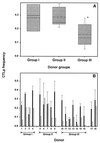The magnitude and specificity of influenza A virus-specific cytotoxic T-lymphocyte responses in humans is related to HLA-A and -B phenotype
- PMID: 11752149
- PMCID: PMC136822
- DOI: 10.1128/jvi.76.2.582-590.2002
The magnitude and specificity of influenza A virus-specific cytotoxic T-lymphocyte responses in humans is related to HLA-A and -B phenotype
Abstract
The repertoire of human cytotoxic T-lymphocytes (CTL) in response to influenza A viruses has been shown to be directed towards multiple epitopes, with a dominant response to the HLA-A2-restricted M1(58-66) epitope. These studies, however, were performed with peripheral blood mononuclear cells (PBMC) of individuals selected randomly with respect to HLA phenotype or selected for the expression of one HLA allele without considering an influence of other HLA molecules. In addition, little information is available on the influence of HLA makeup on the overall CTL response against influenza viruses. Here, the influenza A virus-specific CTL response was investigated in groups of HLA-A and -B identical individuals. Between groups the individuals shared two or three of the four HLA-A and -B alleles. After in vitro stimulation of PBMC with influenza virus, the highest CTL activity was found in HLA-A2(+) donors. A similar pattern was observed for the precursor frequency of virus-specific CTL (CTLp) ex vivo, with a higher CTLp frequency in HLA-A2-positive donors than in HLA-A2-negative donors, which were unable to recognize the immunodominant M1(58-66) epitope. In addition, CTL activity and frequency of CTLp for the individual influenza virus epitopes were determined. The frequency of CTLp specific for the HLA-B8-restricted epitope NP(380-388) was threefold lower in HLA-B27-positive donors than in HLA-B27-negative donors. In addition, the frequency of CTLp specific for the HLA-A1-restricted epitope NP(44-52) was threefold higher in HLA-A1-, -A2-, -B8-, and -B35-positive donors than in other donors, which was confirmed by measuring the CTL activity in vitro. These findings indicate that the epitope specificity of the CTL response is related to the phenotype of the other HLA molecules. Furthermore, the magnitude of the influenza virus-specific CTL response seems dependent on the HLA-A and -B phenotypes.
Figures






Similar articles
-
Preferential HLA usage in the influenza virus-specific CTL response.J Immunol. 2004 Apr 1;172(7):4435-43. doi: 10.4049/jimmunol.172.7.4435. J Immunol. 2004. PMID: 15034059
-
The loss of immunodominant epitopes affects interferon-gamma production and lytic activity of the human influenza virus-specific cytotoxic T lymphocyte response in vitro.Clin Exp Immunol. 2007 May;148(2):296-306. doi: 10.1111/j.1365-2249.2007.03340.x. Epub 2007 Feb 26. Clin Exp Immunol. 2007. PMID: 17326762 Free PMC article.
-
A mutation in the HLA-B*2705-restricted NP383-391 epitope affects the human influenza A virus-specific cytotoxic T-lymphocyte response in vitro.J Virol. 2004 May;78(10):5216-22. doi: 10.1128/jvi.78.10.5216-5222.2004. J Virol. 2004. PMID: 15113903 Free PMC article.
-
Hierarchies of antigen-specific cytotoxic T-cell responses.Immunol Rev. 1998 Aug;164:29-36. doi: 10.1111/j.1600-065x.1998.tb01205.x. Immunol Rev. 1998. PMID: 9795761 Review.
-
Structural and functional distinctiveness of HLA-A2 allelic variants.Immunol Res. 2012 Sep;53(1-3):182-90. doi: 10.1007/s12026-012-8295-5. Immunol Res. 2012. PMID: 22434516 Review.
Cited by
-
Loss in CD4 T-cell responses to multiple epitopes in influenza due to expression of one additional MHC class II molecule in the host.Immunology. 2012 Aug;136(4):425-36. doi: 10.1111/j.1365-2567.2012.03599.x. Immunology. 2012. PMID: 22747522 Free PMC article.
-
Cross-allele cytotoxic T lymphocyte responses against 2009 pandemic H1N1 influenza A virus among HLA-A24 and HLA-A3 supertype-positive individuals.J Virol. 2012 Dec;86(24):13281-94. doi: 10.1128/JVI.01841-12. Epub 2012 Sep 26. J Virol. 2012. PMID: 23015716 Free PMC article.
-
Non-human primate models of human respiratory infections.Mol Immunol. 2021 Jul;135:147-164. doi: 10.1016/j.molimm.2021.04.010. Epub 2021 Apr 23. Mol Immunol. 2021. PMID: 33895579 Free PMC article. Review.
-
Human cytotoxic T lymphocytes directed to seasonal influenza A viruses cross-react with the newly emerging H7N9 virus.J Virol. 2014 Feb;88(3):1684-93. doi: 10.1128/JVI.02843-13. Epub 2013 Nov 20. J Virol. 2014. PMID: 24257602 Free PMC article.
-
Cross-recognition of avian H5N1 influenza virus by human cytotoxic T-lymphocyte populations directed to human influenza A virus.J Virol. 2008 Jun;82(11):5161-6. doi: 10.1128/JVI.02694-07. Epub 2008 Mar 19. J Virol. 2008. PMID: 18353950 Free PMC article.
References
-
- Badovinac, V. P., A. R. Tvinnereim, and J. T. Harty. 2000. Regulation of antigen-specific CD8(+) T cell homeostasis by perforin and interferon-gamma. Science 290:1354–1358. - PubMed
-
- Bednarek, M. A., S. Y. Sauma, M. C. Gammon, G. Porter, S. Tamhankar, A. R. Williamson, and H. J. Zweerink. 1991. The minimum peptide epitope from the influenza virus matrix protein. Extra and intracellular loading of HLA-A2. J. Immunol. 147:4047–4053. - PubMed
-
- Belz, G. T., P. G. Stevenson, and P. C. Doherty. 2000. Contemporary analysis of MHC-related immunodominance hierarchies in the CD8+ T cell response to influenza A viruses. J. Immunol. 165:2404–2409. - PubMed
Publication types
MeSH terms
Substances
LinkOut - more resources
Full Text Sources
Other Literature Sources
Molecular Biology Databases
Research Materials
Miscellaneous

